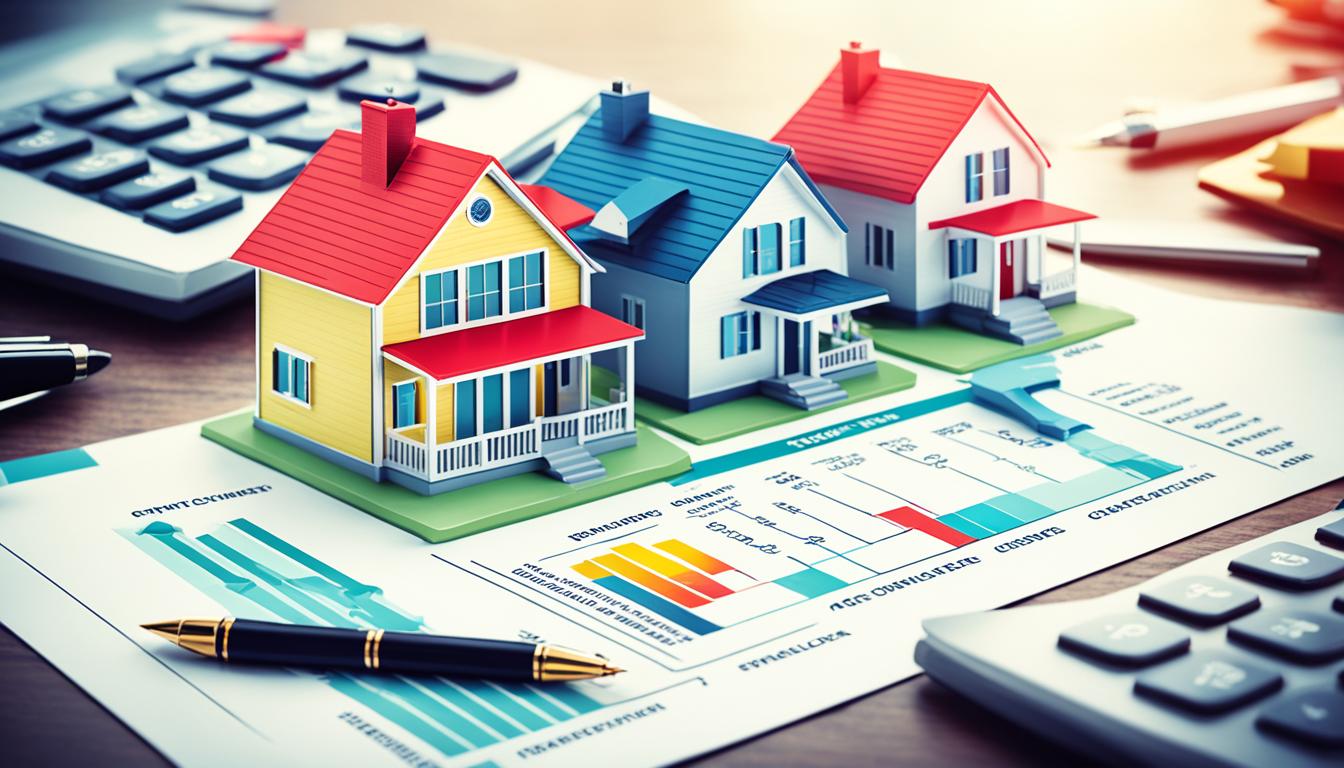Did you know over 60% of American homeowners have a fixed-rate mortgage? This type of loan is popular for its stability. But there are other options out there. It’s important to know the differences between fixed-rate mortgages, adjustable-rate mortgages, and revolving/offset home loans.
This article will give you a detailed look at these loan types. We aim to help you make a choice that fits your financial goals and how much risk you can handle. Whether you’re buying your first home or you’ve owned one before, this guide will simplify home financing for you.
Key Takeaways
- Fixed-rate mortgages offer stability, with predictable monthly payments throughout the loan term.
- Adjustable-rate mortgages provide flexibility, but also carry the risk of fluctuating interest rates.
- Revolving/offset home loans offer a unique approach, allowing you to use your home equity as a line of credit.
- Understanding the pros and cons of each loan type is crucial in selecting the right home financing solution.
- Factors like interest rates, loan terms, and repayment strategies should be carefully considered when choosing a home loan.
Demystifying the Different Types of Home Loans
When financing a home, you have two main mortgage options: fixed-rate and adjustable-rate mortgages. Knowing the pros and cons of each can help you choose the right one for your financial goals and risk level.
Fixed-Rate Mortgages: A Stable Choice
Fixed-rate mortgages have a steady, predictable payment every month. This stability is great for homeowners who like knowing their mortgage interest rates and monthly costs. The pros of fixed-rate mortgages are:
- Consistent monthly payments, making budgeting easier
- Protection from interest rate changes, offering long-term financial security
- Potential for lower monthly payments over time compared to ARMs
The cons of fixed-rate mortgages are:
- Higher initial interest rates than ARMs
- Less chance to take advantage of lower interest rates
- Longer commitment, usually 15 or 30 years
Adjustable-Rate Mortgages: Flexibility with Risk
ARMs have interest rates that change with the market. This flexibility is good for borrowers who think their income or finances will change. The pros of ARMs are:
- Lower initial mortgage interest rates than fixed-rate mortgages
- Ability to benefit from lower interest rates in the future
- Potentially lower monthly payments at first
The cons of ARMs are:
- Unpredictable monthly payments due to rate changes
- Potential for much higher payments if rates go up
- More financial risk and uncertainty over time
When picking between a fixed-rate or adjustable-rate mortgage, think about your finances, risk level, and goals. This will help you choose the mortgage loan features that fit your needs best.
“The key to making a wise decision is to understand the trade-offs between the stability of a fixed-rate mortgage and the potential savings of an adjustable-rate mortgage.”
Revolving/Offset Home Loans: A Unique Approach
Revolving or offset home loans are a special choice for financing a home. They let borrowers use their home’s value as a credit line. This means they can get money when they need it, which might save them money on interest.
A big plus of a revolving home loan or an offset home loan is you can pay extra without a penalty. This is great for people with changing incomes or those wanting to pay off their loan quicker. By paying more at once or regularly, you can cut down the loan balance and the interest you pay.
Also, a home equity line of credit (HELOC) is a key part of these loans. It lets homeowners use their home’s value for cash when they need it. This can be for fixing up the house, paying off debt, or reaching other financial goals. HELOCs usually have lower costs and better rates than traditional mortgage refinances.
Looking into a revolving home loan or an offset home loan means understanding the details, fees, and risks. These loans have special benefits but also variable rates and the chance of more debt if not handled well. Talking to a financial advisor can help figure out if these loans fit your long-term money plans.

“Revolving home loans provide homeowners with the flexibility to access their home equity when needed, empowering them to make strategic financial decisions.”
Factors to Consider When Choosing a Home Loan
Choosing the right home loan is a big decision that affects your financial future. You need to think about two main things: mortgage interest rates and market trends, and the loan term and how you want to pay it back.
Interest Rates and Market Trends
Mortgage interest rates change with the economy and market conditions. It’s important to know the current trends and what’s expected. This helps you understand your monthly payments and the loan’s total cost. By keeping up with the market, you can make a choice that fits your financial plans and budget.
Loan Term and Repayment Strategy
The length of your mortgage, or the loan term, affects your payments. Shorter terms, like 15-year mortgages, have lower rates but higher monthly payments. Longer terms, such as 30-year mortgages, offer lower payments but you pay more interest over time. Think about how you plan to pay off the loan, including extra payments or refinancing, to find the best term for you.
FAQ
What is the difference between a fixed-rate mortgage and an adjustable-rate mortgage?
A fixed-rate mortgage has a steady monthly payment for the loan’s life. An adjustable-rate mortgage has rates that change with the market. This gives more flexibility but also more risk.
What is a revolving/offset home loan?
A revolving or offset home loan lets you use your home’s equity as a line of credit. This can save you money and give you more flexibility. You can get funds as you need them, which might lower your total interest paid.
What factors should I consider when choosing a home loan?
Think about current interest rates and market trends when picking a home loan. Also, consider the loan term and how you want to pay it back. These things affect your monthly payments and the loan’s total cost. Choosing the right loan helps meet your financial goals and personal situation.
How do interest rates and market trends affect my home loan decision?
Interest rates greatly impact your monthly payments and the loan’s total cost. Keeping an eye on market trends helps you understand how interest rates might change. This knowledge aids in making a smart choice about the best loan and when to get it for your goals.
What are the advantages and disadvantages of different loan terms and repayment strategies?
Loan terms and repayment strategies influence your financial future. Shorter loans have lower rates but higher payments. Longer loans have lower payments but cost more in interest. Think about these when picking a loan to fit your budget and financial goals.

